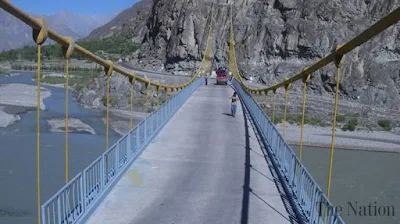Minister of Works Dr Muhammad Iqbal says the government has decided to replace wooden bridges with RCC bridges in all ten districts of Gilgit-Baltistan, reported Radio Pakistan.
He said this in an interview to our Gilgit corresponded.
The wooden bridges are in large numbers in Gilgit-Baltistan (GB) some constructed before independence of Pakistan. As the number of tourists have increased in norther areas of Pakistan in recent past, the government is working on developing the infrastructure of the region.
Danyore Suspension Bridge is in the Gilgit-Baltistan region of Pakistan, and is one of the oldest make shift suspension bridges in the region. The bridge connects Danyor to the premises of the Karakoram University across the River Hunza. Currently the bridge is closed for vehicles and only pedestrians and motorcyclists are allowed to pass through. Winds coming from northwest of the valley set the suspension bridge to swing inducing minute resonances, it is therefore declared unsafe for normal traffic. There has been constructed a two way concrete bridge beside it, that is being used as an alternative which was completed in 2013.Before the construction of the suspension bridge of Danyor there used to be a boat which is locally called Jaalo (a traditional raft for the passage crossing rivers and lakes) was used to cross the Hunza River. The bridge was constructed in mid-sixties. The Danyore side of the bridge is connected to a tunnel that was dug by the then residents of Danyore without any engineering tools and equipments almost a decade later
Alam Bridge : Built with a combination of iron rods and wood over the Gilgit River, the Alam Bridge is one of the scariest bridges in the world. The bridge linking Baltistan region to Gilgit and the rest of the country is about 300 metres in length.This wooden, wire suspension bridge over the Gilgit River was built by Chinese and Pakistani engineers in 1978. In view of its dangers, regional authorities are deployed at the bridge to ensure vehicles don’t exceed the speed limit. In addition, trucks and other loaded vehicles weighing more than 20 tons are not allowed to pass.
Gilgit
Gilgit city is situated in the north of Pakistan which is the capital of Gilgit- Baltistan. It is the hometown of beauty, various cultures and numerous languages. Gilgit region has been given many names like Jewel of Pakistan, Asia’s wonderland and Roof of the world, whereas it is considered to be the paradise when it comes to explaining the beauty of this region. Strategically speaking, Gilgit is one of the most important regions of Pakistan as it links Pakistan with China and is only 15 km away from Central Asia. However, despite the efforts of the local government of Gilgit- Baltistan to officially become a part of Pakistan as its 5th province, the Pakistani Government has put in little or no efforts to declare this region Pakistan’s official Province.
Gilgit has majority of Shia population with Sunnis, Ismailis and Aghakhanis and foreign hands take advantage of this sectarian divide and every now and then issues arises between these sects which disrupts the peace in the city. Besides so many law and order situations, Gilgit still stands at the top in the most beautiful places of the world which does not only have beauty on surface level but is rich in minerals as well. If we explore the culture of Gilgit, we realize that it is home to many ethnic groups. Exploring the culture of Gilgit brings out a mix plate of culture and traditions. Five different languages are spoken in the region, which includes Balti, Khowar, Brushaski and Wakhi. However, Shina is the basic language that is commonly spoken in the entire Gilgit-Baltistan region.
Moving down the memory lane Gilgit has had a very critical position geographically and has remained the hot plate for political and military rivalries between Russian, British and Chinese rulers. It was also the main region on Silk Road when the teachings of Buddha arrived in region from South Asia, but for now Shias, Sunni, Agha Khanis and Ismailis are in the region. The exact location of Gilgit is just a little off from the Karokoram Highway. It can be reached by air as well as by road. But the road tour is not considered to be safe these days due to high threats of terrorism.
Tags:
Tourism

